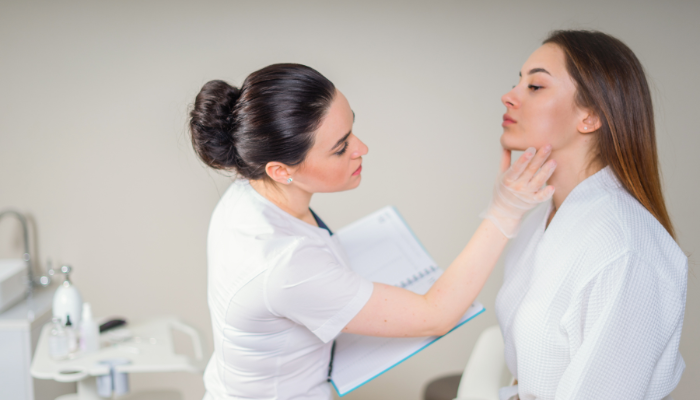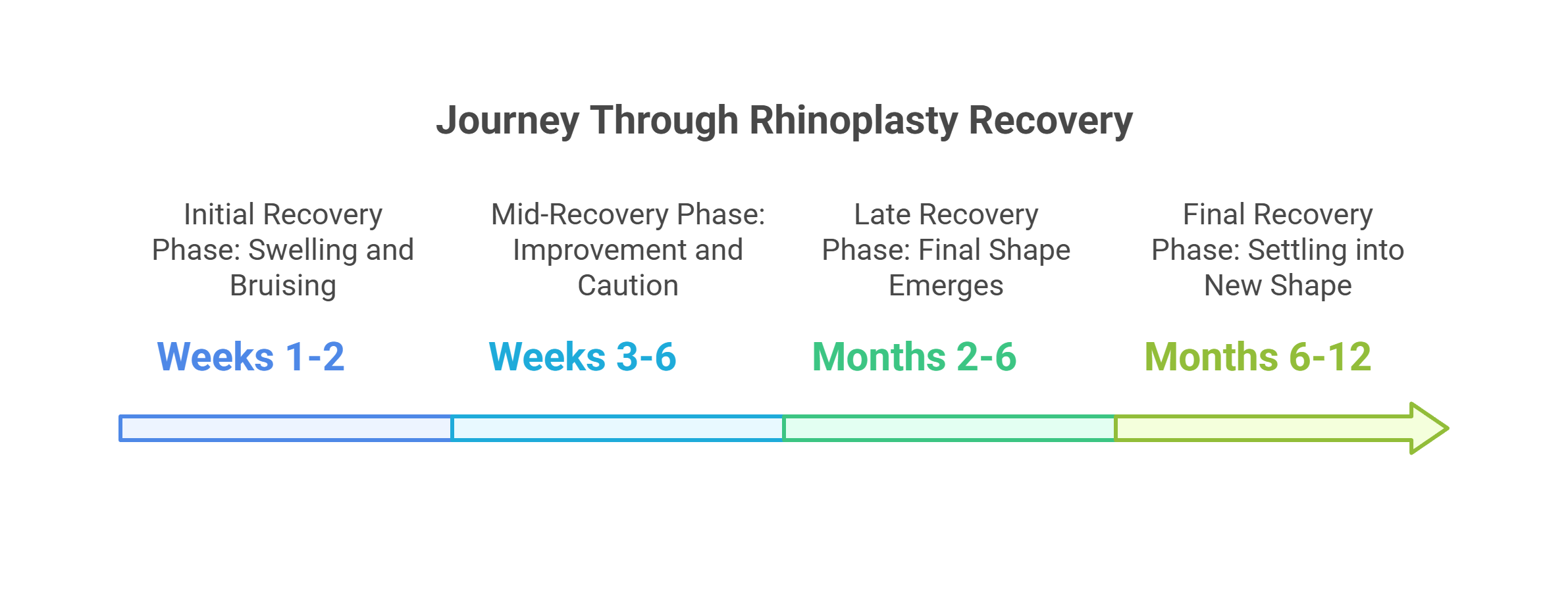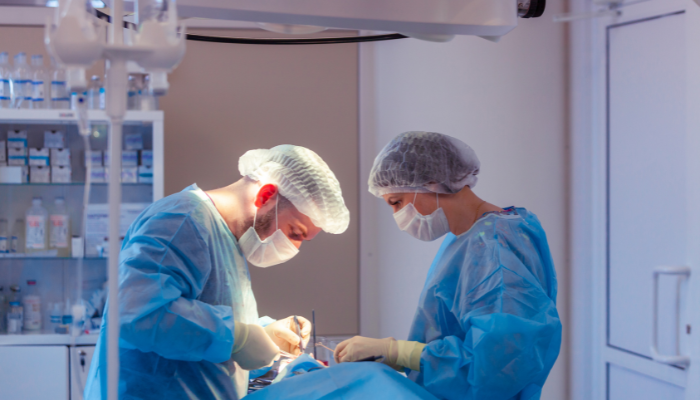Rhinoplasty is a surgical procedure that reshapes the nose for both cosmetic and functional reasons. If you’re thinking about getting one, you might be wondering: how long does rhinoplasty last?
The answer isn’t straightforward, as it depends on various factors like the surgical method used, your unique healing process, and how the natural ageing of your body affects your nose over time. This article will explore these aspects in detail, helping you understand what to expect from your rhinoplasty results over the years.
Key Takeaways
- Rhinoplasty results are typically permanent, but natural ageing can affect the appearance over time.
- The first year post-surgery is crucial for healing and settling into the final shape.
- Factors such as surgical technique and individual healing can influence how long the results last.
- Regular follow-ups with your surgeon can help maintain the desired aesthetic.
- Lifestyle choices, like sun protection and skincare, can affect the longevity of your results.
Understanding Rhinoplasty Results

Getting a rhinoplasty is a big decision, and understanding what to expect is key. Let’s break down the basics to give you a clearer picture.
What Is Rhinoplasty?
Rhinoplasty is a surgical procedure to reshape the nose. People get it for all sorts of reasons, from wanting to improve their appearance to fixing breathing problems. It’s all about making the nose look and function better. The surgery can involve altering bone, cartilage, and skin.
Types of Rhinoplasty
There are different types of rhinoplasty, and the best one for you depends on your specific needs and goals. Here are a few common ones:
- Suture Lift Rhinoplasty: A minimally invasive technique that uses sutures to subtly lift and reshape the nose without major surgery. It’s ideal for mild adjustments and has a quicker recovery time.
- Open Rhinoplasty: The surgeon makes a small cut between your nostrils to access the underlying structures. It gives them more visibility and control, especially for major reshaping.
- Closed Rhinoplasty: All incisions are made inside the nose. It’s less invasive, but might not be suitable for complex changes.
- Tip Plasty: Focuses only on reshaping the tip of the nose. It’s often a quicker procedure with a shorter recovery.
- Functional Rhinoplasty: This aims to improve breathing by correcting structural issues inside the nose, like a deviated septum.
Common Reasons for Rhinoplasty
People choose rhinoplasty for a variety of reasons. It’s not just about looks; sometimes it’s about improving quality of life. Here are some common motivations:
- Aesthetic Concerns: Reshaping a nose that’s too large, crooked, or has bumps.
- Breathing Difficulties: Correcting a deviated septum or other structural issues that obstruct airflow.
- Injury or Trauma: Repairing damage from a broken nose or other facial injuries.
- Birth Defects: Correcting nasal deformities present from birth.
Rhinoplasty can be a really positive experience, but it’s important to have realistic expectations. The goal is to enhance your natural features and improve your overall facial harmony, not to create a completely different face. Talking openly with your surgeon about what you want to achieve is super important.
Factors Influencing Longevity
So, you’re probably wondering what actually affects how long your rhinoplasty results will last. It’s not just a simple case of ‘one size fits all’. Several things come into play, and understanding them can help you manage your expectations and even take steps to prolong the outcome.
Surgical Techniques
The type of surgical technique used can have a big impact. For example, a surgeon who uses more advanced, structural techniques is likely to create results that are more stable over time.
This is because these techniques focus on reshaping the underlying cartilage and bone, rather than just removing tissue. Think of it like building a house – a strong foundation will last longer.
Individual Healing Processes
Everyone heals differently, it’s just a fact. Genetics, your overall health, and even your lifestyle can influence how your body responds to surgery. Some people might experience more swelling or scarring, which can subtly alter the final result over time.
It’s a bit like baking a cake – even with the same recipe, the outcome can vary slightly depending on your oven and ingredients.
Ageing and Natural Changes
Let’s face it, we all age. And as we age, our faces change. Skin loses elasticity, and the underlying structures shift. This can affect the appearance of your nose, even after rhinoplasty. It’s not necessarily a bad thing, but it’s something to be aware of. Think of it as your nose ‘maturing’ with you.
It’s worth remembering that while rhinoplasty can provide long-lasting results, it can’t stop the natural ageing process. However, understanding the factors that influence longevity can help you make informed decisions and take steps to maintain your desired outcome for as long as possible.
Here are some things that can affect how your nose will look in the future:
- The technique used during your rhinoplasty
- The skill and experience level of your surgeon
- Your genetics
Short-Term Expectations After Surgery
What can you actually expect in the weeks immediately following the procedure? It’s a bit of a rollercoaster, to be honest, but knowing what’s coming can make it a lot less scary. Let’s break it down.
Initial Recovery Period
Right after surgery, you’re going to feel it, no sugar-coating. Expect some discomfort, but it’s manageable with the painkillers your surgeon prescribes.
You’ll likely have a splint and maybe some packing inside your nose. Breathing through your mouth will be the norm for a bit, which can be annoying. The first week is mostly about rest and following your surgeon’s instructions to the letter.
Here’s a quick rundown of what to expect in that first week:
- Swelling and bruising around the nose and eyes. Cold compresses are your best friend.
- Nasal congestion due to swelling and packing.
- Pain or discomfort, controlled by medication.
- Limited activity. No strenuous exercise, bending over, or heavy lifting.
Visible Changes in the First Month
Okay, so the splint’s off (usually after a week or so), and you’re starting to see what’s underneath. But don’t get too excited just yet! Swelling is still a major player.
Your nose will look bigger than it will eventually, and it might feel a bit numb. Bruising should start to fade, but it can linger.
It’s important to remember that the initial appearance isn’t the final result. Patience is key. The swelling takes time to subside, and the nose will continue to refine its shape over the coming months.
Managing Post-Operative Care
This is where you really take control of your recovery. Follow these tips, and you’ll be golden:
- Keep your head elevated, especially when sleeping. This helps reduce swelling.
- Avoid blowing your nose. Seriously, don’t do it! It can disrupt the healing process.
- Take any prescribed medications as directed. Don’t skip doses.
- Attend all follow-up appointments with your surgeon. They’ll monitor your progress and address any concerns.
- Be gentle when cleaning your face. Avoid putting pressure on your nose.
- Avoid sun exposure. Wear a hat and sunscreen if you need to be outside.
And remember, everyone heals at their own pace. Don’t compare your recovery to someone else’s. Just focus on following your surgeon’s advice and taking care of yourself.
The First Year: Settling Into Your New Nose

The first year is a bit of a rollercoaster, but it’s also when you’ll see the most significant changes as your nose settles into its new shape. It’s a period of patience and trusting the process, but also a time to really start enjoying the results.
Swelling and Healing Timeline
Most of the initial swelling will go down in the first few months, but it’s not unusual to have subtle swelling lingering for up to a year. It’s like your nose is slowly revealing its final form, bit by bit.
Don’t freak out if you notice changes – it’s all part of the healing process. To help things along:
- Keep your head elevated, especially when sleeping.
- Apply cool compresses (but not directly on the nose).
- Avoid strenuous activities that could put pressure on your nose.
Final Shape Realisation
This is the exciting part! Around the one-year mark, you should be seeing something very close to your final result. It’s when all that waiting and careful post-op care really pays off. But remember, everyone heals at their own pace, so try not to compare your progress to others. If you’re concerned, always check in with your surgeon.
Emotional Adjustment
Rhinoplasty isn’t just a physical change; it can be an emotional one too. It’s normal to feel a mix of excitement, anticipation, and maybe even a little anxiety as you adjust to your new appearance.
It’s important to give yourself time to adapt and embrace the changes. If you’re struggling, don’t hesitate to reach out to friends, family, or a therapist for support. Remember, it’s okay to feel however you’re feeling.
And hey, if you’re feeling good, that’s great too!
Long-Term Results: Years One to Five
So, you’ve had your rhinoplasty, the initial recovery is done, and you’re settling into your new look. What can you expect as time goes on? Let’s look at what happens in the years following your surgery.
Stability of Results
Generally, the period from one to five years post-rhinoplasty is when you’ll see the most stable results. The major changes have already occurred, and the nose should maintain its refined shape. Any minor swelling should be completely gone by this point, and you’ll be enjoying the full benefits of the procedure. It’s a pretty good feeling, to be honest.
Ageing Effects on the Nose
Of course, it’s important to remember that your nose, like the rest of your face, will continue to age. Skin elasticity naturally decreases over time, and there might be subtle changes to the underlying structure.
However, the fundamental improvements achieved through rhinoplasty should still be noticeable and positive. It’s more about how your new nose ages gracefully with the rest of you.
Maintaining Aesthetic Improvements
While the results of rhinoplasty are generally long-lasting, there are things you can do to help maintain them. These include:
- Protecting your skin from excessive sun exposure.
- Maintaining a healthy lifestyle.
- Avoiding significant facial trauma.
It’s worth noting that everyone’s experience is different. Some people might see minimal changes over these years, while others might notice slight shifts. Regular check-ups with your surgeon can help monitor any changes and address any concerns you might have.
Beyond Five Years: Ageing with Your Rhinoplasty

So, you’ve had your rhinoplasty, you’re past the initial recovery, and you’re loving your new nose. But what happens as the years roll on? It’s a fair question, and it’s important to have realistic expectations about how your nose will change over time.
Natural Changes Over Time
As we age, so does our skin and the underlying structures of our face, including the nose. Skin loses elasticity, and cartilage can weaken. This means that even with rhinoplasty, your nose will be subject to these natural changes.
The effects are usually subtle, but it’s worth being aware of them. For example, the tip of the nose might droop slightly as the years go by.
Potential for Revision Surgery
While rhinoplasty results are generally long-lasting, some people might consider a revision surgery down the line. This isn’t necessarily because the original surgery failed, but more often to address age-related changes or minor tweaks to maintain the desired aesthetic. Revision surgeries are typically less extensive than the initial procedure.
Long-Term Care Tips
To help maintain the results of your rhinoplasty as you age, here are a few things you can do:
- Maintain a healthy lifestyle: A balanced diet and regular exercise contribute to overall skin health.
- Protect your skin from the sun: Wear sunscreen to prevent premature ageing and sun damage.
- Stay hydrated: Drinking plenty of water helps keep your skin supple.
It’s important to remember that everyone ages differently. Genetics, lifestyle, and environmental factors all play a role in how your nose will change over time. Regular check-ups with your surgeon can help you stay informed and address any concerns.
Maximising the Lifespan of Your Rhinoplasty
Naturally, you’ll want to keep your nose looking its best for as long as possible. While the procedure offers long-lasting changes, there are definitely things you can do to help maintain those results over the years. It’s all about making smart choices and taking good care of yourself.
Lifestyle Choices
Your lifestyle has a bigger impact than you might think. Smoking, for example, can really mess with your skin’s elasticity and overall appearance, potentially affecting the rhinoplasty results.
A balanced diet and staying hydrated are also important for keeping your skin healthy and resilient. Think of it as investing in the long-term health of your nose!
Skincare and Sun Protection
Sun protection is a must. The nose is, after all, right there in the sun’s path. Too much sun can cause premature ageing, which can affect the skin on your nose. Make sure you’re using a good quality sunscreen with a high SPF every day, even when it’s cloudy.
And don’t forget to moisturise! Good skincare will help keep the skin around your nose supple and healthy.
Regular Follow-Up Consultations
Don’t skip those follow-up appointments with your surgeon. They’re not just a formality; they’re a chance for your surgeon to check how your nose is healing and to spot any potential issues early on.
They can also give you personalised advice on how to care for your nose in the long term. Think of it as a regular service for your new nose!
It’s worth remembering that everyone ages differently, and some changes are inevitable. However, by making smart lifestyle choices, protecting your skin, and keeping up with your follow-up appointments, you can give your rhinoplasty the best chance of lasting for many years to come.
Conclusion
Rhinoplasty can provide lasting results that often endure for a lifetime. While the initial changes are permanent, it’s important to remember that natural ageing and lifestyle factors can still influence the appearance of your nose over time.
If you’re considering this procedure, it’s essential to consult with a qualified surgeon who can guide you through the process and help set realistic expectations. With the right care and attention, you can enjoy the benefits of your rhinoplasty for many years to come.
Frequently Asked Questions
What is rhinoplasty?
Rhinoplasty, often called a nose job, is a surgery that changes the shape of your nose. People choose it for looks or to fix breathing problems.
How long do the results of rhinoplasty last?
Rhinoplasty results are usually permanent. Once the nose is reshaped, it should stay that way for life, although ageing can change its appearance over time.
What factors can affect how long rhinoplasty results last?
Several things can affect the results, like the technique used during surgery, your healing process, and how you take care of your nose afterward.
What should I expect immediately after the surgery?
After surgery, you will have some swelling and bruising. It may take a few weeks for these to go down, and you’ll need to follow care instructions from your doctor.
Will I need revision surgery in the future?
Some people may want revision surgery later on if they are not happy with the results or if their nose changes due to ageing or injury.
How can I take care of my nose after surgery?
To help your nose heal well, avoid strenuous activities, protect it from the sun, and follow your doctor’s advice on care and follow-up appointments.





